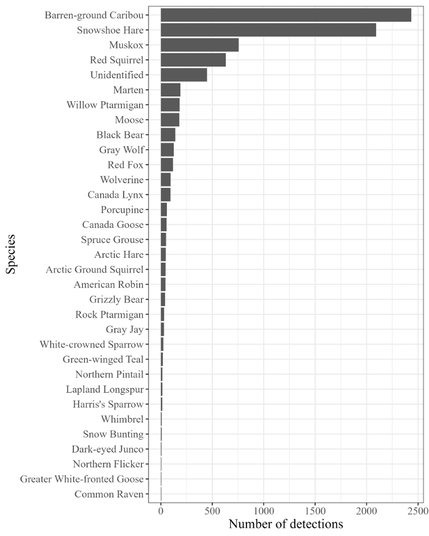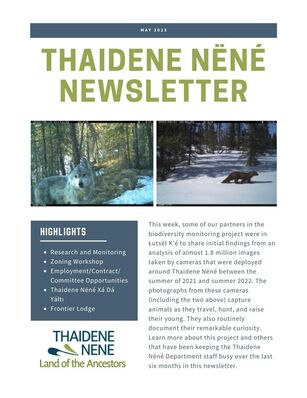|
In this short video, travel through beautiful Thaidene Nëné with Łutsël K’é Dene Elder JC Catholique. See the magnificent vistas and hear why this place, the Land of Our Ancestors, is so important to our people.
Northern Indigenous communities like ours are well aware of the benefits of guardian and harvester programs, which include serving as the eyes and ears of our communities on the land and water and supplying our people with food and medicine. Unfortunately, the value of these programs and the impacts that they are having is not always recognized by decision-makers and funders.
Ni Hat’ni Dene is one of four hunter/harvester/guardian programs currently being supported by MakeWay to develop evaluation tools that are easy to use and provide information that is of use to our communities while also satisfying the expectations of funders. The others are the Joint Secretariat, which administers the Imaryuk and Munaqsiyit Monitoring Programs in the Inuvialuit Settlement Region of the Northwest Territories (NWT); the Dechinta Centre for Research and Learning in Yellowknife, NWT; and the Ittaq Heritage and Research Centre in Clyde River, Nunavut. The four programs met in person for the first time in June 2022 at Dechinta’s camp on Mackenzie Island. Over four days, the twenty-five participants shared about their programs and the opportunities and challenges they face in carrying out their work. Since then, each program has been working with an evaluation partner to design responsive tools that can collect, analyze, and share important outcomes related to their programs, such as harvest distribution, on-the-land learning and skill development, and intergenerational knowledge transfer. One evaluation partner, Tiffany Scurr, was in Łutsël K’é in last month to meet with Ni Hat’ni Dene guardians and other members of the Thaidene Nëné and Wildlife, Lands and Environment departments. Over the week that she was in town, Tiffany learned about the different ways the two departments are currently gathering information and shadowed the guardians during regular daily activities. She also talked to guardians and administrators about what is and is not working in the related processes of collecting, analyzing, and reporting on data. Mostly importantly, staff in both departments identified what information they need and what stories they want to tell. Over the coming months, the guardians will work with the evaluation partners to design tools that meet the needs of the Thaidene Nëné and Wildlife, Lands and Environment departments. They will also develop tools that will translate the information being gathered into a format that works for funders. Over the longer term, the four programs will work with evaluation partners to develop an economic evaluation model that will demonstrate the value of harvester and guardian programs so that funders can see the “return on their investment.” This work builds on the development of the Hunter/Harvester/Guardian Evaluation Toolkit, which was released in 2021. The toolkit was developed in collaboration with northern Indigenous communities and organizations to support the design and implementation of evaluations to assess the impacts of hunter/harvest/guardian programs. The hope is that by using a common approach to evaluation, programs across the North can learn from one another and also communicate the benefits of these programs to decision-makers and funders. We're so excited to launch the visitor orientation video for the Thaidene Nëné Indigenous Protected Area. In this short video, learn more about Thaidene Nëné and how you can be a good guest when you visit our homeland. Marsi cho to everyone who contributed to this video including Elders Emelie Saunders, JC Catholique, and Florence Catholique; the staff of the Thaidene Nëné Department; Artless Collective; Pat Kane Photography; and Alietum.
You can also watch the video on our YouTube channel. Over the last two years, Łutsël K’é’s Thaidene Nëné Department has been collaborating with researchers from the Government of the Northwest Territories, Canadian Wildlife Service, Parks Canada, Wilfrid Laurier University, and the University of British Columbia on a project to monitor biodiversity in the protected area. The project uses remote cameras and audio recorders to document the movements and sounds of wildlife. Our research partners are almost finished processing the millions of photographs and many hours of audio recordings captured in the first year of the project. As we wait for the remaining cameras and recorders to be processed, we thought it would be interesting to share some of the preliminary results of this research. Cameras The cameras that have been processed so far have taken pictures of 57 species: 19 mammals and 38 birds. The most commonly seen animals so far are barren-ground caribou (2,434 detections) and snowshoe hare (2,093 detections). This project uses the word "detections" to describe the number of times one species was recorded at a camera location. A detection can involve one animal or many animals. A detection can be a single photograph or several thousand photographs. For example, a large group of caribou that spends several hours moving past a camera on the tundra may result in hundreds of photographs but would be recorded as one detection for that species at that location. An important part of this project is looking at these photographs with Elders and harvesters and asking questions like: What do you think about this animal? Is it healthy? When an animal (or animals) spends time in front of one of the cameras, we can put the photographs together to make a little video. These little videos allow us to look more closely at animal behaviour and ask questions like: What is this animal doing? Is that typical? Making maps from the information captured in the photographs can give us an idea of where certain animals are in Thaidene Nëné. When we show maps like these to Elders and harvesters, we can learn more about whether the animals are where they would expect them to be or if they are in different places. One of the animals that community members have questions about are muskox. In recent years, muskox have been seen more often below the treeline and near Łutsël K’é. The orange dots show camera stations that took pictures of muskox. The larger the dot, the more photographs taken at that station of muskox. The map affirms community observations. One of the interesting things about the photographs from this project is that they give us a glimpse of the day-to-day lives of animals. We can watch lynx being lynx and bears doing bear things. We can also watch animals interacting with one another, like in this video of a wolverine chasing a hare. So far, we’ve talked about what the cameras can show us about animals. They can also provide us with information about the land, including weather, snow cover, freeze up, and green up. These two videos capture a full-year of photographs taken at two stations: one in the forest and one on the tundra.
Audio RecordersThe audio units do not record continuously. They are programmed to record sounds from April 1 to October 31 and only at certain times of day. For most of the recording season, they capture sound for 10 minutes per hour starting one hour before sunset and ending five hours after sunrise. They also record ten minutes of sound every day at 12:00pm and 3:00pm. This station was located north and a little bit east of Kezuchaı́ Tué (Siltaza Lake).
The audio units record more than just bird song. They also capture the sounds of frogs, bats, wolves, and insects, and they can provide us with information about human activities, including boat and air traffic and shotgun blasts. While it is most important for our people to be on the land, watching and listening, Thaidene Nëné is very big. The cameras and audio recorders can be our eyes and ears when we are not able to be there.
 It's newsletter time! This issue has information and updates on the biodiversity monitoring program, the lake ice monitoring program, a recent zoning workshop, Thaidene Nëné Xá Dá Yáłtı, and Frontier Lodge. It also has a FULL PAGE of employment, contract, and committee opportunities. If you have suggestions for the newsletter or for Thaidene Nëné communications and/or operations, please let us know. Our door is always open. We will have paper copies for community members shortly. In the meantime, check out the digital version. |
AuthorWrite something about yourself. No need to be fancy, just an overview. Archives
March 2024
Categories |
CONNECT |
VISIONWe are the Lutsel K’e Dene First Nation. Our vision for Thaidene Nëné is:
Nuwe néné, nuwe ch'anıé yunedhé xa (Our land, our culture for the future). We’re working with our partners to permanently protect Thaidene Nëné—part of our huge and bountiful homeland around and beyond the East Arm of Tu Nedhé. |
